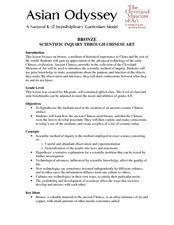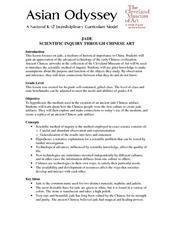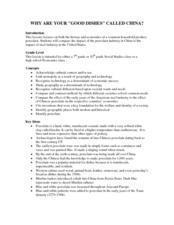Mr. Roughton
Chinese Dynasties
From the Q'in to the Ming, get the facts on the great Chinese dynasties from early history with these great handouts and worksheets. Presented in a Word document, they include the years the dynasties were in existence, the dynasty...
Curated OER
Science in History Part I: the Abacus To the Modern Computer
In this math information worksheet, learners read one page factual accounts of the early math inventions of the abacus, the calculator and early computers. There are 40 questions to answer about the reading.
Curated OER
Dynastic Explorations
Students complete a unit of lessons on medieval Chinese dynasties. They examine the impact the Chinese culture has had on their own lives, label maps, conduct research, read stories, create bamboo stick sentences, write poems, and make...
Curated OER
Bronze: Scientific Inquiry through Chinese Art
Learners examine the use of bronze and porcelain in Chinese art and commerce through in-class activities, role play events, and small-group discussions in this exciting Social Studies/Arts lesson.
Curated OER
Paper: Scientific Inquiry Through Chinese Art
Students create replicas of Chinese hanging scrolls in an attempt to understand the technology behind the creation and use of paper in Ancient China. This three-day lesson includes enrichment ideas.
Curated OER
Chinese Games
Students investigate the concepts related to the development of Chinese Games. They work with the teacher to point out important events in history that are related to their development and the influence of games upon the Chinese culture.
Curated OER
Jade: Scientific Inquiry Through Chinese Art
Young scholars discover the uses of Jade in Chinese art and society through in-class discussions, group projects, and internet research. Additional enrichment activities are included.
Curated OER
Silk: Scientific Inquiry Through Chinese Art
Students investigate the many uses of silk in Chinese society through in-class experiments, group projects, and hands-on learning in this cross-curricular instructional activity. There are four main activities included in this...
Weebly
Ancient China
From China's physical geography and earliest beginnings of civilization to the Qin and Han dynasties, here is a nicely designed worksheet on ancient China, which includes a graphic organizer and timeline to summarize the reading material.
Curated OER
Time Line Of Chinese And Japanese Art
Students create individual time lines placing various works of Asian art into chronological order. The information gathered is used to create one class time line for display.
Curated OER
CyberHunt: Ancient China
Pupils participate in various web based activities about ancient China in order to discover the accomplishments of this extraordinary culture. In this history instructional activity, students explore the Chinese paper making recipes,...
Curated OER
China: How to Put Some "Tang" in Your Medieval Dynasties
Fourth graders label the countries that border China and the physical features of Asia. They discuss the physical features of Asia and label them on the other map.
Curated OER
Reading Comprehension Worksheet: China
For this reading comprehension worksheet, students read a passage about kites in China, then answer 3 short answer questions related to the passage.
Curated OER
Why Are Your "Good Dishes" Called China?
Students link monopoly as a result of geography and technology. They recognize technology as a determinant of economic success. Students recognize cultural diffusion based upon societal wants and needs. They compare and contrast methods...















